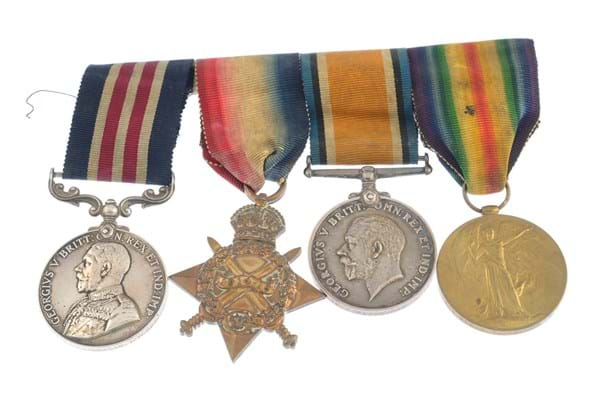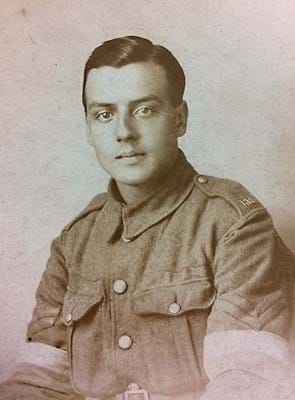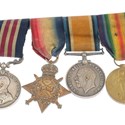The honour in question is the First World War Victory Medal, many of which have been offered just recently at auction thanks to the Armistice centenary.
In an article for the Spink Insider autumn magazine on these medals, Peter Duckers writes that it had been common enough practice in earlier times for nations to award their own campaign medals to the armed forces of their allies.
However, when it came to rewarding service in the First World War, the Allies faced “a huge problem in this respect. If the Allies gave their own version of the war medal to all the forces of their allies, there would have been a complex exchange of literally millions of different medals and the average soldier would have ended up with a chestful of awards. It would have looked impressive but would have been an administrative and financial nightmare.”
At the Treaty of Versailles in 1919 a solution was found: each country would award a standardised form of medal. However, there were some variations – discussed below.
Case studies
So, ‘millions of medals’ does not denote a high value. But a Victory Medal group coming up at Fellows’ auction on December 3 starts to give clues of how higher results can be achieved.
The Victory Medal was never awarded by itself – the most common campaign medals with it are the 1914-15 Star and British War Medal 1914-20. But this Fellows group also has a Military Medal. It is also named to ‘311 Pte E. Fairbanks’, ID - 116755-1. He served in the 1st battalion of the Welsh Guards, and he resided in Alton, Hampshire.
Immediately we have more interest: the British and South African medals were all awarded named, and with one of the great attractions of medals being the backstory and opportunities for research, a name gives value. The 1st battalion Welsh Guards detail also helps – many medal collectors go for specific regiments or regions.
And of course there is the Military Medal. This award was instituted in March 1916, for NCOs and men of the army (including RFC and RND) for individual or associated acts of bravery not of sufficient heroism to merit the Distinguished Conduct Medal.
It isn’t a rare medal in itself – 115,600 were award in the Great War, not including bars for subsequent awards of the same honour – but adds interest to Pte Fairbanks’ group so the estimate at Fellows is £300-400 rather than under £100 perhaps otherwise.
Obviously, the rarer and more prestigious the honours accompanying the Victory Medal are, the more valuable a medal group will be. For example, a Military Cross group may go up to several thousand pounds.
Research possibilities
Medal collectors love documentation and photographs, all helping with that backstory and research.
A good example of this adding value to a normal Victory Medal group came at Derbyshire saleroom Hansons on November 22. While Corporal George Charles Goulding's Victory Medal group was nothing out of the ordinary, it included other very interesting items giving value.
Goulding served in the Signals Section in France during the war and delivered one of the cease hostilities’ messages to announce the end of the war at 11am on November 11, 1918. That very message was included in the lot, as were photos of Goulding and a tin containing pictures of his wife, Mary – known as Minn – who served in the Dublin Red Cross.
Modestly estimated at £50-100, a reasonable level for a normal Victory Medal group, those extra items and backstory helped to take it to a hammer price of £300.
Plaque presence
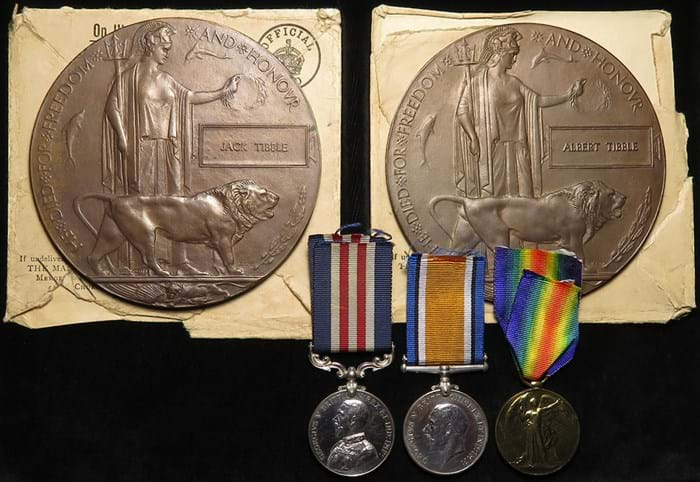
First World War Military Medal medal trio and memorial Plaque for Pte Albert Tibble, plus the plaque for his brother, sold together for £700 at Lockdales.
Another addition to a Victory Medal lot boosting value is the ‘death penny’ – aka the Memorial Plaque which was issued after the First World War to the next-of-kin of all British and Empire service personnel who were killed.
On their own these plaques are worth £50-80, but with a Victory Medal group it becomes more valuable. And a group offered in the Lockdales auction in Ipswich on November 17 gives a clue as to monetary value.
This lot estimated at £600-650 comprised a Military Medal (MM) casualty group - MM (452208 Pte A Tibble 2/11 London Regt.), British War Medal and Victory (452208 Pte A Tibble 11-Lond R) and 'Death Plaque' (Albert Tibble) plus addressed plaque envelope.
The MM was one of six awarded for the third Ypres battle in September 1917. Tibble, attached to the 175th Infantry Brigade, was later killed in action on March 24, 1918, serving with 21st (County of London) Bn (1st Surrey Rifles). Born in Fulham, west London, Tibble is commemorated on the Arras Memorial.
This highly poignant lot also included his brother’s Memorial Plaque 2103. Pte Jack Tibble 1st/13th Kensington Bn, London Regt, died on July 8, 1916, and is buried in Abbeville Communal Cemetery. Again the plaque envelope was included, and much copied research.
So, not only a Victory Medal to a Great war casualty, but a Memorial Plaque, Military Medal and his brother’s plaque, including the original envelopes – plus names and research opportunities.
All this added up to a £700 hammer price.
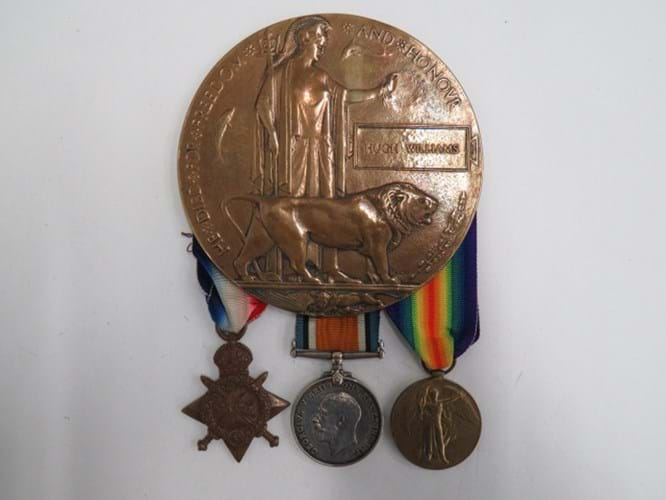
This 1914-15 star medal trio including Victory Medal sold for £400 hammer at Marlow’s auction in Stafford on November 22 (estimate £200-300). It shows the value of a named casualty medal with Memorial Plaque included. It was awarded to Private Hugh Williams 13078, 9th Battalion Devonshire Regiment, who died on July 1, 2016 – the first day of the Somme, on which 20,000 British soldiers were killed. He is commemorated on the Thiepval memorial.
The rarest Victory Medals
Duckers’ article in Spink Insider magazine outlines another boost to Victory Medal value – one that gives the elusive rarity for such a ubiquitous medal. Those awarded to other countries within the Allies, even not with names included, can be very valuable given the lower numbers issued.
While countries such as Belgium and Romania issued about 300,000 VMs, by the time you get to Brazil (about 2500), Cuba (6000-7000), and Union of South Africa (about 75,000) there is indeed a rarity value.
As for Siam, Duckers notes these VMs are “the rarest and therefore the most expensive of the series” but also warns that “dangerous copies exist”. Only about 1500 were issued, awarded to the 1200 members of the expeditionary force sent to France in 1918 and to those who transported them.
Buying the various Allied VMs has become a collecting quest in itself.


